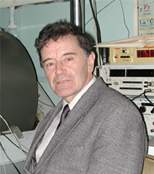LABORATORY OF MOLECULAR RADIOSPECTROSCOPY
|
 Head of the laboratory: Head of the laboratory:
Ovchinnikov Igor Vasil'evich,
Professor, Dr.Sc., Honoured researcher of RF and RT
tel.: +7 (843) 272 06 73
e-mail: ovchinnikov@kfti.knc.ru
|
Staff and postgraduate students:
Goncharov V.A. (Ph.D.), Domracheva N.E. (Dr.Sc.), Ivanova T.A.( Ph.D.), Frolova E.N.(Ph.D.), Yurtaeva S.V.(Ph.D.), Ivanova G.I., Turanov A.N.(Ph.D.), Turanova O.A.(Ph.D.)
Main fields of research:
Synthesis of paramagnetic metal-containing liquid crystals. Investigation of metallomesogenes, crystals and solutions of paramagnetic complexes with radiospectroscopy techniques.
Directions and results of research
Synthesis and investigation of magnetic liquid crystals with differential scanning calorimetry, polarization microscopy, EPR, NMR, magnetic susceptibility, X-ray phase and diffraction analysis techniques. First paramagnetic metal-containing liquid crystals (smectics and nematics) have been produced on the basis of coordination compounds of 3d elements. Liquid crystals on the basis of complexes of 4f rare-earth elements and possessing magnetic properties record-breaking for liquid crystals, have been obtained. Polynuclear metallomesogenes have been synthesized. The existence of low-dimensional supramolecular structures of metallomesogenes with correlated spin and electric properties has been established. EPR has been developed for studying liquid-crystalline metal-containing systems.
The investigation of magnetic resonance and relaxation phenomena (EPR, FMR, PMR, dielectric relaxation) with the correlation analysis of the thermal noise. A method for determining the equilibrium macroscopic dipole correlation function of the substance (as well as its external zero-field dielectric response and complex permittivity functions) on the basis of fluctuation measurement data has been elaborated. This could serve as a straightforward method for investigating the equilibrium molecular motion and a method for determining magnetic resonance and magnetic relaxation characteristics of paramagnets with the correlation analysis of the thermal noise in the receiving coil containing the substance under investigation.
The following equipment has been developed: microthermometers, insensitive to high- and microwave-frequency electromagnetic fields; the rotary microviscosimeter; the movable-sample integrating magnetometer recommended to be introduced into the practice of physical/chemical investigations as well as into the clinical practice.
The investigation of paramagnetic ion and ion-exchange polymer solutions. Original equipment developed within the laboratory and relaxation techniques for nonresonance absorption in parallel fields as well as EPR are used to study short spin-lattice and spin-spin relaxation times (down to 10-9 s) of paramagnetic ions in disordered media (solutions, polycrystals, cross-linked polymers). Data on the structure of hydrated and solvate shells of a number of ions and formation of various structural microinhomogeneities from molecules of the dissolved substance and those of the solvent have been obtained. The translational and the rotational mobility of complexes in solutions and of single structural elements in ferroelectric polycrystals has been characterized. For systems with dipole-dipole and exchange interactions a transition from the purely liquid to the quasi-solid approximation, within which statistical memory effects are manifest has been determined. A correlation between the structural setup and properties of a number of ion exchangers has been revealed.
Research of the role of exchange and electron-vibrational interactions in the formation of the structure and physicochemical properties of substances.EPR is used to study fundamental aspects of exchange interactions and crystal lattice dynamics; appearance of local instabilities in ion and molecular structures with degenerate and pseudo-degenerate electronic states. The conditions for the cooperative ordering to occur and its effect on the conductivity and structural properties have been revealed.
Contacts with the other institutions, international co-operation
- Kazan State University, Kazan
- Kazan State Technological University, Kazan
- Saint-Petersburg State University, Saint Petersburg.
- Kiev University, Kiev, Ukraine.
- University of Exeter, Exeter, England.
- University of Leuven, Leuven, Belgium.
- Technical University, Darmstadt, Germany.
- University of Bayreuth, Bayreuth, Germany.
- Institute of Molecular Physics, Poznan, Poland.
- Adam Mickiewricz University, Poznan, Poland.
- Institute Charles Sadron - C.N.R.S, Strasbourg, France.
Basic publications
-
Ovchinnikov I.V., Galyametdinov Yu.G.: Liguid-Crystal Coordination Compounds. Achievements and Prospectives. Koord.Khimiya 22, 334 (1996)
-
Galyametdinov Yu., Atnanassopoulou M., Grisar K., Kharitonova O., Tinchurina L., Ovchinnikov I., Haase W.: Synthesis and Magnetic Investigations of Rare-Earth Containing Liguid Crystals with Large Magnetic Anisotropy. Chem. Mater. 8, 922 (1996)
-
Julmetyev R.M., Vishnevskaya G.P., Frolova E.N.: Manifestation of Non-Markovian Behavior of Molecular System in Electron Spin Relaxation of Paramagnetic Ions in Solutions. NPCS 2, 52-60 (1999)
-
Yablokov Yu.V., Usachev A.E., Ivanova T.A.: Modeling of Cooperative Properties of Inorganic Compounds. Koord.Khimiya 23, 31 (1997)
-
Voronkova V.K., Mrozinski J., Yablokov Yu.V.: A Vibronic Effect and the Rate of the Migration Process of the "Extra" Electron for Some Oxo-Bridged Fe(III)-Fe(IV) Dimers. Z. Phys. Chem. 201, 181 (1997)
|


 Head of the laboratory:
Head of the laboratory: